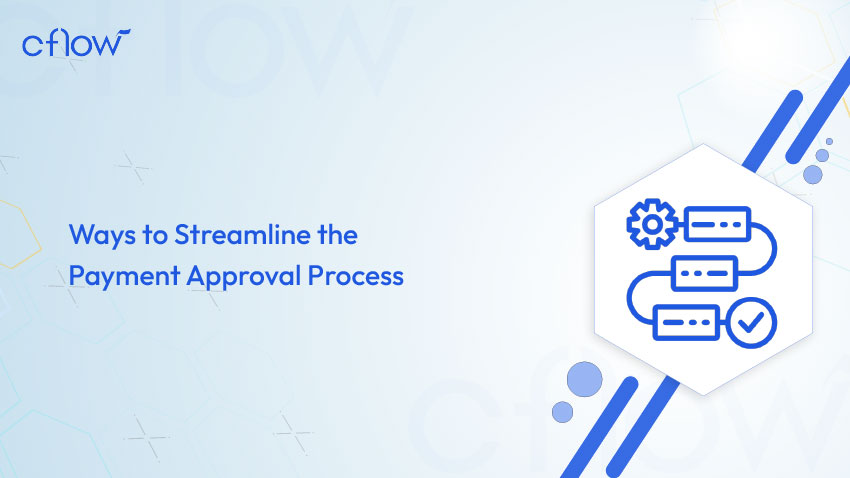Payment Approval Workflows – Streamlining the Payment Approval Process

Key takeaways
- Automating the payment approval process ensures timely vendor payments, reduces manual errors, and improves financial efficiency across accounts payable workflows.
- Manual approval methods often lead to delays, missed deadlines, and strained vendor relationships—automation solves these issues with real-time tracking and streamlined checks.
- A well-defined, automated approval workflow increases transparency, prevents fraud, and supports better cash flow management for growing businesses.
- Tools like Cflow offer no-code automation, enabling finance teams to digitise approval paths, enforce role-based thresholds, and ensure accurate, on-time payments effortlessly.
Payment approval for vendor invoices has a direct bearing on business success. On-time vendor payments translate to mutually beneficial business relationships. Are manual payment approval processes capable of scaling up to the expanding requirements of growing businesses? Definitely not! Manual payment approvals are marred by delays and bottlenecks, the net result being compromised vendor relationships.
Automated payment approval workflows are the solution. The most effective way to streamline the payment approval process would be to automate the workflow so that redundancies are eliminated and payments are done on time.
This blog explores the payment approval workflow and the benefits of automation.
What is the Payment Approval Process?
Accounts payable processes play an integral part in the success of a business and its overall efficiency. In simple terms, the payment approval process involves all the steps involved in the review and approval of vendor payments. So, what are the steps involved in the payment approval process?
1. Checking the invoice for accuracy
The payment approval process begins with a review of the details on the invoice to ensure that the details are accurate. Details on the products or services delivered need to be examined to ensure that they align with the purchase order or contract agreement. The amount charged by the vendor also needs to be verified to ensure that it is in agreement with what was discussed with the vendor. Other details like quantities and other credits, sales tax assessments, etc, can also be part of the invoice verification process.
2. Verifying invoice dates
Check the dates of all the goods and services mentioned on the invoice and cross-reference them with past invoices to ensure that there is no overlap. If an overlap of dates occurs, then you need to follow up with the vendor to ensure that you are not being charged twice for the same purchase.
Discover why teams choose Cflow
3. Confirming with the Project Manager
If the vendor invoice covers services that were overseen by someone else, then you need to check with the project manager for the job to ensure that the work was performed to their satisfaction and confirm if all the elements of the project that you are being billed for were satisfactorily delivered.
4. Recording the Invoice Deadlines
Keeping track of the invoice payment deadline is important in the payment approval process. While filing the invoice records, file them by the invoice due date. If suppliers offer discounts for early payments, make a note of that too and also confirm whether it is possible to meet the early payment deadline to save money.
5. Scheduling the payment
Once all the verification steps have been successfully completed, vendor payment needs to be scheduled. You need to schedule the payment at least a few days before the payment deadline so that you get a buffer in case any issues or unforeseen delays arise when you make the payment.
The payment approval process entails several steps that are data-intensive and time-consuming, especially the ones that involve data verification. At scale, these steps can eat up a substantial amount of work time for the accounts payable team. Timely execution of these steps is crucial for invoice processing and sustained vendor relationships.
Why Should You Streamline the Payment Approval Process?
A streamlined payment approval process makes the accounts payable process more efficient and helps save costs. Setting up a clear payment approval workflow for the accounts payable function is a must to ensure timely payments. Why should you streamline the payment approval process? Here is why –
Eliminate internal fraud
A streamlined payment approval workflow standardises the process, which eliminates fraud and duplication. In the absence of a workflow, issues like cutting corners, signing blank cheques, and duplicate payments arise.
Assign responsibilities
A payment approval workflow equips the team with proper controls and checks on the payments that go out of the organisation. Without these checks and balances in place, it is difficult to gauge who is responsible for what in the approval process.
Avoid late payments
The main issue when companies don’t have a proper payment workflow in place is late payments. The more paper-based invoice processing that happens in the company, the slower the overall process will be. This results in late payments that affect the company’s cash flow negatively and hamper supplier relationships.
You can get started with Cflow for free
Better transparency and oversight over payments
A streamlined approval workflow provides teams with transparency over the status of payments. Teams are fully aware of the status of each payment and, hence, control all payments that go through the system.
Minimise errors in invoices and inaccuracies in payments
Deeper transparency into payments helps reduce errors and inaccuracies in invoice processing. The chance of fraud and embezzlement is also eliminated in a streamlined payment approval workflow.
Maintain good vendor relationships
The most important reason for streamlining the payment approval workflow is maintaining and building strong vendor relationships. Businesses love customers who pay their bills on time. Consistent time;y payment patterns will encourage suppliers to consider offering you additional discounts and rewards. Also, they will strive to fulfil your orders on time once they know that you are a reliable client.
Given the benefits that businesses stand to gain from streamlining their approval workflows, automated payment workflows must definitely be considered. A workflow automation software like Cflow is highly effective in streamlining the business workflow by automating data-intensive and repetitive steps in the process.
Try Cflow for free, no credit card needed
Ways to Streamline the Payment Approval Process
You can avoid late fees and pay your bills faster with a streamlined payment approval workflow. We have listed some easy-to-implement ways to improve the efficiency of the payment approval process.
1. Approve Purchase Orders Immediately
When you have to approve an invoice, and you realise that the purchase order has not been approved in the first place, it leads to a lot of time and energy wastage. You can consider requiring purchase orders only so your accounts payable team can take care of the invoice payments later.
2. Set thresholds for invoice approvals
Setting cost and time thresholds for approval of payments is a good way to streamline and accelerate approvals. Minor authorised purchases such as office supplies can be approved without the need for discussing any invoice details with superiors.
3. In-person approvals
For small businesses, setting up a system where the accounts payable team directly goes to the approver in person to discuss any invoice details and get approvals on the spot can be set up. Another way is to schedule weekly approval meetings that enable bulk approval of payments.
4. Set Negative Approvals Policy
In some situations, requests for approvals get buried in people’s inboxes, which slows down the process drastically. Here is where the policy of negative approvals may be useful. When the accounts payable team sends the invoice to the approver for review and approval, and does not hear back from them in a certain amount of time, then they can consider the invoice approved.
5. Approval automation
This is by far the most effective way of streamlining the payment approval workflow. Automating approvals in the accounts payable system takes care of approvals so that invoices are processed more efficiently and payments are made quickly. The invoice approval process can be automated based on recurring bill payments for any vendors that regularly invoice a set amount. This way, not only is the approval process accelerated, but fraud and duplication are also avoided.
End-to-end workflow automation
Build fully-customizable, no code process workflows in a jiffy.
Creating the Payment Approval Workflow
Payment approval workflows vary depending on the type and size of the business. So, how do you create the right payment approval workflow for your business? Ask yourself the following questions and design the workflow accordingly –
Who – decides on who the stakeholders are in the approval process? Possible stakeholders are office managers, personnel in charge of purchasing, external accountants, or in-house bookkeepers. Once you have this information, assigning roles in the approval process becomes easy.
How much? What are the amounts that each person in the workflow is allowed to approve? Setting up thresholds in the approval process becomes easy once you have this information.
What – What type of action will trigger the workflow? This is a very important criterion for designing the workflow. Setting the trigger action right decides the direction of the workflow. Trigger action examples include – when an invoice is added to the system, or when it is ready to be paid.
Transform your AI-powered approvals
Conclusion
Manual payment approvals can no longer keep up with the pace and demands of modern businesses. Delays, errors, and lack of visibility in traditional processes put vendor relationships and cash flow at risk. Automating the payment approval workflow is not just a smart move—it’s a necessary step for operational efficiency and financial control. By adopting a no-code solution like Cflow, businesses can eliminate bottlenecks, enforce approval policies, and ensure every invoice is processed accurately and on time. Ready to take control of your accounts payable process?
Start your free trial with Cflow today and experience streamlined approvals with zero hassle.
Frequently Asked Questions
1. What is a payment approval workflow?
A payment approval workflow is a structured process used to verify, review, and approve vendor invoices before making payments. It typically includes steps like invoice validation, budget checks, stakeholder approvals, and payment scheduling.
2. Why should businesses automate payment approvals?
Automation eliminates manual errors, prevents delays, ensures compliance, and streamlines invoice processing. It improves transparency and helps maintain strong vendor relationships by ensuring timely payments.
3. How does delayed payment approval affect vendor relationships?
Delays in invoice approvals can frustrate vendors, damage trust, and even result in late fees or service disruptions. Timely approvals strengthen partnerships and may lead to early-payment discounts.
4. What types of businesses can benefit from payment approval automation?
Businesses of all sizes—from startups to large enterprises—benefit from automating their payment workflows. It’s especially helpful for companies with growing vendor lists and recurring invoice cycles.
5. Can I set approval thresholds for different invoice amounts?
Yes, modern workflow tools like Cflow allow you to define custom approval thresholds based on invoice value, department, or vendor type, ensuring the right people approve the right invoices.
6. How long does it take to set up an automated payment approval process?
With no-code tools like Cflow, businesses can build and launch a custom payment approval workflow within minutes using a visual drag-and-drop interface—no coding required.
7. How is an invoice approved for payment?
An invoice is approved for payment through a structured review process that ensures its accuracy and legitimacy. It typically starts with verifying the invoice details—such as vendor name, amount, purchase order match, and delivery confirmation. Once verified, the invoice is routed to the appropriate approvers based on internal policies or thresholds. After all approvals are obtained, the invoice is scheduled for payment according to the due date or early payment terms. Automating this process with workflow tools ensures faster approvals, fewer errors, and better compliance.
Related Articles:
- Approval Workflows: Time to Ditch Your Email Ping-Pongs!
- Approval Workflow Software: A Dynamic Approach to Automation
- Waltzing through Document Approval Workflows with No Code Automation
- 5 Effective Ways to Ensure Email Approval Does not Fall Through the Cracks
- What is Invoice Approval Workflow and How to Improve and Optimise it?
- Automated Invoice Approval Workflow – the Path to Establishing Strong Vendor Relationships
What should you do next?
Thanks for reading till the end. Here are 3 ways we can help you automate your business:

Do better workflow automation with Cflow
Create workflows with multiple steps, parallel reviewals. auto approvals, public forms, etc. to save time and cost.

Talk to a workflow expert
Get a 30-min. free consultation with our Workflow expert to optimize your daily tasks.

Get smarter with our workflow resources
Explore our workflow automation blogs, ebooks, and other resources to master workflow automation.

